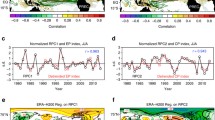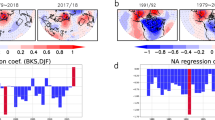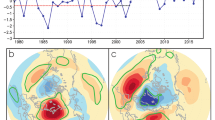Abstract
Early studies have suggested a linkage between the surface warming over the Barents-Kara Seas and the strength of the Siberian high in boreal winter. Here, we show that the linkage is not stable, and with an apparent interdecadal change in the late-1990s. Coinciding with Arctic surface warm anomalies in recent decades (1997–2017), the Siberian high has been significantly intensified, the East Asian jet stream has expanded westward, and an apparent Rossby wave has propagated from the Arctic to East Asia, suggesting an atmospheric teleconnection between midlatitudes and Arctic. In contrast, midlatitude atmospheric circulation anomalies coinciding with Arctic surface warm anomalies were barely statistically significant during 1979–1996. The associated strong anomalous ascending/descending motions and divergent/convergent upper troposphere air masses over the Arctic-Eurasian sector seem to have favored the midlatitude-Arctic linkage during 1997–2017. We further hypothesize that Arctic mid-tropospheric warming plays a crucial role for the linkage between midlatitudes and Arctic in boreal winter. Multi-model simulations support this, and also point to internal atmospheric variability as the cause for the interdecadal shift in the strength of the midlatitude-Arctic linkage.











Similar content being viewed by others
References
Allan R, Ansell T (2006) A new globally-complete monthly historical gridded mean sea level pressure data set (HadSLP2): 1850–2004. J Clim 19:5816–5841
Balsamo G, Viterbo P, Beljaars A, Hurk BVD, Hirschi M, Betts AK, Scipal K (2009) A revised hydrology for the ECMWF model: verification from field site to terrestrial water storage and impact in the Integrated Forecast System. J Hydrometeorol 10:623–643
Bueh C, Fu X, Xie Z (2011) Large-scale circulation features typical of wintertime extensive and persistent low temperature events in China. Atmos Ocean Sci Lett 4:235–241
Chen X, Luo D, Feldstein SB, Lee S (2017) Impact of winter Ural blocking on Arctic sea ice: short-time variability. J Clim 31:2267–2282
Cheung HN, Zhou W, Shao Y, Chen W, Mok HY, Wu MC (2013) Observational climatology and characteristics of wintertime atmospheric blocking over Ural-Siberia. Clim Dyn 41:63–79
Cohen J et al (2014) Recent Arctic amplification and extreme mid-latitude weather. Nat Geosci 7:627–637
Cohen J, Pfeiffer K, Francis JA (2018) Warm Arctic episodes linked with increased frequency of extreme winter weather in the United States. Nat Commun 9:869
Dee DP et al (2011) The ERA-Interim reanalysis: configuration and performance of the data assimilation system. Q J R Meteorol Soc 137:553–597
Ding Y (1990) Build-up, air mass transformation and propagation of Siberian high and its relations to cold surge in East Asia. Meteorol Atmos Phys 44:281–292
Ding Y, Krishnamurti TN (1987) Heat budget of the Siberian high and the winter monsoon. Mon Weather Rev 115:2428–2449
Dong X, Xue F, Zhang H, Zeng Q (2012) Evaluation of surface air temperature change over China and the globe during the twentieth century in IAP AGCM4.0. Atmos Ocean Sci Lett 5:435–438
Feng C, Wu B (2015) Enhancement of winter Arctic warming by the Siberian high over the past decade. Atmos Ocean Sci Lett 8:257–263
Francis JA, Vavrus SJ (2012) Evidence linking Arctic amplification to extreme weather in mid-latitudes. Geophys Res Lett 39:L06801
Francis JA, Vavrus SJ (2015) Evidence for a wavier jet stream in response to rapid Arctic warming. Environ Res Lett 10:014005
Gao Y et al (2015) Arctic sea ice and Eurasian climate: a review. Adv Atmos Sci 32:92–114
Graversen RG, Wang M (2009) Polar amplification in a coupled climate model with locked albedo. Clim Dyn 33:629–643
Graversen RG, Mauritsen T, Tjernström M, Källén E, Svensson G (2008) Vertical structure of recent Arctic warming. Nature 451:53–56
He S (2015) Asymmetry in the Arctic Oscillation teleconnection with January cold extremes in Northeast China. Atmos Ocean Sci Lett 8:386–391
He S, Wang H (2012) An integrated East Asian winter monsoon index and its interannual variability. Chin J Atmos Sci 36:523–538
He S, Wang H (2013) Impact of the November/December Arctic Oscillation on the following January temperature in East Asia. J Geophys Res 118:12981–12998
He S, Wang H, Xu X, Li J (2016) Impact of Arctic warming and the super El Nino in winter 2015/2016 on the East Asian climate anomaly. Trans Atmos Sci 39:735–743
Hu C, Yang S, Wu Q (2015) An optimal index for measuring the effect of East Asian winter monsoon on China winter temperature. Clim Dyn 45:2571–2589
Inoue J, Hori ME, Takaya K (2012) The role of Barents sea ice in the wintertime cyclone track and emergence of a warm-Arctic cold-Siberian anomaly. J Clim 25:2561–2568
Jeong JH, Ou T, Linderholm HW, Kim BM, Kim SJ, Kug JS, Chen D (2011) Recent recovery of the Siberian high intensity. J Geophys Res 116:D23102
Jhun JG, Lee EJ (2004) A new East Asian winter monsoon index and associated characteristics of the winter monsoon. J Clim 17:711–726
Jin C, Zhou T, Guo Z, Wu B, Chen X (2016) Improved simulation of the East Asian winter monsoon interannual variation by IAP/LASG AGCMs. Atmos Ocean Sci Lett 9:204–210
Kim BM et al (2014) Weakening of the stratospheric polar vortex by Arctic sea-ice loss. Nat Commun 5:4646
Kug JS, Jeong JH, Jang YS, Kim BM, Folland CK, Min SK, Son SW (2015) Two distinct influences of Arctic warming on cold winters over North America and East Asia. Nat Geosci 8:759–762
Kumar KK, Rajagopalan B, Cane MA (1999) On the weakening relationship between the Indian monsoon and ENSO. Science 284:2156–2159
Lee HJ et al (2017) Impact of poleward moisture transport from the North Pacific on the acceleration of sea ice loss in the Arctic since 2002. J Clim 30:6757–6769
Li F, Gao Y (2015) The project Siberian high in CMIP5 models. Atmos Ocean Sci Lett 8:179–184
Li F, Wang H (2013) Autumn sea ice cover, winter Northern Hemisphere annular mode, and winter precipitation in Eurasia. J Clim 26:3968–3981
Li Y, Yang S (2010) A dynamical index for the East Asian winter monsoon. J Clim 23:4255–4262
Li F, Wang H, Gao Y (2014) On the strengthened relationship between the East Asian winter monsoon and Arctic Oscillation: a comparison of 1950–70 and 1983–2012. J Clim 27:5075–5091
Li F, Wang H, Gao Y (2015) Change in sea ice cover is responsible for non-uniform variation in winter temperature over East Asia. Atmos Ocean Sci Lett 8:376–382
Li S, He S, Li F, Wang H (2018) Simulated and projected relationship between the East Asian winter monsoon and winter Arctic Oscillation in CMIP5 models. Atmos Ocean Sci Lett 11:417–424
Lind S, Ingvaldsen RB, Furevik T (2018) Arctic warming hotspot in the northern Barents Sea linked to declining sea-ice import. Nat Clim Change 8:634–639
Liu J, Curry JA, Wang H, Song M, Horton RM (2012) Impact of declining Arctic sea ice on winter snowfall. Proc Natl Acad Sci 109:4074–4079
Luo D, Xiao Y, Yao Y, Dai A, Simmonds I, Franzke CLE (2016) Impact of Ural blocking on winter warm Arctic-cold Eurasian anomalies. Part I: Blocking-induced amplification. J Clim 29:3925–3947
Luo B, Luo D, Wu L, Zhong L, Simmonds I (2017) Atmospheric circulation patterns which promote winter Arctic sea ice decline. Environ Res Lett 12:054017
Marsh DR, Mills MJ, Kinnison DE, Lamarque JF, Calvo N, Polvani LM (2013) Climate change from 1850 to 2005 simulated in CESM1 (WACCM). J Clim 26:7372–7391
McCusker KE, Fyfe JC, Sigmond M (2016) Twenty-five winters of unexpected Eurasian cooling unlikely due to Arctic sea-ice loss. Nat Geosci 9:838–842
Mori M, Watanabe M, Shiogama H, Inoue J, Kimoto M (2014) Robust Arctic sea-ice influence on the frequent Eurasian cold winters in past decades. Nat Geosci 7:869–873
Neale RB, Richter J, Park S, Lauritzen PH, Vavrus SJ, Rasch PJ, Zhang M (2013) The mean climate of the Community Atmosphere Model (CAM4) in forced SST and fully coupled experiments. J Clim 26:5150–5168
Ogawa F et al (2018) Evaluating impacts of recent Arctic sea ice loss on the northern hemisphere winter climate change. Geophys Res Lett. https://doi.org/10.1002/2017gl076502
Onarheim IH, Årthun M (2017) Toward an ice-free Barents Sea. Geophys Res Lett 44:8387–8395
Onarheim IH, Eldevik T, Årthun M, Ingvaldsen RB, Smedsrud LH (2015) Skillful prediction of Barents Sea ice cover. Geophys Res Lett 42:5364–5371
Outten SD, Esau I (2012) A link between Arctic sea ice and recent cooling trends over Eurasia. Clim Change 110:1069–1075
Overland JE, Miletta Adams J, Bond NA (1999) Decadal variability of the Aleutian Low and its relation to high-latitude circulation*. J Clim 12:1542–1548
Overland JE, Wood KR, Wang M (2011) Warm Arctic-cold continents: climate impacts of the newly open Arctic Sea. Polar Res 30:157–171
Overland J, Francis JA, Hall R, Hanna E, Kim SJ, Vihma T (2015) The melting Arctic and midlatitude weather patterns: are they connected? J Clim 28:7917–7932
Panagiotopoulos F, Shahgedanova M, Hannachi A, Stephenson DB (2005) Observed trends and teleconnections of the Siberian high: a recently declining center of action. J Clim 18:1411–1422
Reynolds RW, Smith TM, Liu C, Chelton DB, Casey KS, Schlax MG (2007) Daily high-resolution-blended analyses for sea surface temperature. J Clim 20:5473–5496
Screen JA, Francis JA (2016) Contribution of sea-ice loss to Arctic amplification is regulated by Pacific Ocean decadal variability. Nat Clim Change 6:856–860
Screen JA, Simmonds I (2010) The central role of diminishing sea ice in recent Arctic temperature amplification. Nature 464:1334–1337
Screen JA, Deser C, Simmonds I (2012) Local and remote controls on observed Arctic warming. Geophys Res Lett 39:L10709
Screen JA et al (2018) Consistency and discrepancy in the atmospheric response to Arctic sea-ice loss across climate models. Nat Geosci 11:155–163
Shindell D, Faluvegi G (2009) Climate response to regional radiative forcing during the twentieth century. Nat Geosci 2:294–300
Smedsrud LH et al (2013) The role of the Barents Sea in the Arctic climate system. Rev Geophys 51:415–449
Sorokina SA, Li C, Wettstein JJ, Kvamstø NG (2016) Observed atmospheric coupling between Barents Sea ice and the warm-Arctic cold-Siberian anomaly pattern. J Clim 29:495–511
Sun L, Perlwitz J, Hoerling M (2016) What caused the recent “warm Arctic, cold continents” trend pattern in winter temperatures? Geophys Res Lett 43:5345–5352
Sung M-K, Kim S-H, Kim B-M, Choi Y-S (2018) Interdecadal variability of the warm Arctic and cold Eurasia pattern and its North Atlantic origin. J Clim 31:5793–5810
Takaya K, Nakamura H (2001) A formulation of a phase-independent wave-activity flux for stationary and migratory quasigeostrophic eddies on a zonally varying basic flow. J Atmos Sci 58:608–627
Takaya K, Nakamura H (2005) Mechanisms of intraseasonal amplification of the cold Siberian high. J Atmos Sci 62:4423–4440
Vavrus SJ (2018) The influence of Arctic amplification on mid-latitude weather and climate. Curr Clim Change Rep 4:238–249
Wang S, Liu J (2016) Delving into the relationship between autumn Arctic sea ice and central–eastern Eurasian winter climate. Atmos Ocean Sci Lett 9:366–374
Wang B, Wu Z, C-p Chang, Liu J, Li J, Zhou T (2010) Another look at interannual-to-interdecadal variations of the East Asian winter monsoon: the northern and southern temperature modes. J Clim 23:1495–1512
Woods C, Caballero R (2016) The role of moist intrusions in winter Arctic warming and sea ice decline. J Clim 29:4473–4485
Wu B, Wang J (2002) Possible impacts of winter Arctic Oscillation on Siberian High, the East Asian winter monsoon and sea–ice extent. Adv Atmos Sci 19:297–320
Xu X, He S, Li F, Wang H (2018a) Impact of northern Eurasian snow cover in autumn on the warm Arctic–cold Eurasia pattern during the following January and its linkage to stationary planetary waves. Clim Dyn 50:1993–2006
Xu X, Li F, He S, Wang H (2018b) Sub-seasonal reversal of East Asian surface temperature variability in winter 2014/2015. Adv Atmos Sci 35:737–752
Yang S, Lau KM, Kim KM (2002) Variations of the East Asian jet stream and Asian-Pacific-American winter climate anomalies. J Clim 15:306–325
Yao Y, Luo D, Dai A, Simmonds I (2017) Increased quasi stationarity and persistence of winter Ural blocking and Eurasian extreme cold events in response to Arctic warming. Part I: insights from observational analyses. J Clim 30:3549–3568
Zhu Y, Wang H, Wang T, Guo D (2018) Extreme spring cold spells in North China during 1961–2014 and the evolving processed. Atmos Ocean Sci Lett 11:432–437
Acknowledgements
This research was supported by the National Key R&D Program of China (2016YFA0600703), the CONNECTED supported by UTFORSK Partnership Program (UTF-2016-long-term/10030), the Research Council of Norway supported project SNOWGLACE (244166/E10) and InterDec (260393), the National Natural Science Foundation of China (Grants 41875118, 41505073, 41605059, 41421004, and 41790472), the Young Talent Support Program by China Association for Science and Technology (Grant 2016QNRC001), the Postgraduate Research & Practice Innovation Program of Jiangsu Province (KYCX18_0997), the funding of Jiangsu innovation and entrepreneurship team, and the Priority Academic Program Development (PAPD) of Jiangsu Higher Education Institutions.
Author information
Authors and Affiliations
Corresponding author
Additional information
Publisher's Note
Springer Nature remains neutral with regard to jurisdictional claims in published maps and institutional affiliations.
Rights and permissions
About this article
Cite this article
Xu, X., He, S., Gao, Y. et al. Strengthened linkage between midlatitudes and Arctic in boreal winter. Clim Dyn 53, 3971–3983 (2019). https://doi.org/10.1007/s00382-019-04764-7
Received:
Accepted:
Published:
Issue Date:
DOI: https://doi.org/10.1007/s00382-019-04764-7




